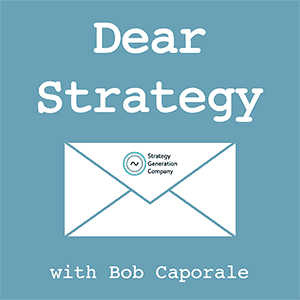Dear Strategy:
“How do you make sure there is an effective inter-working between different levels in a dynamic strategy evolution?”
“Dynamic Strategy Evolution” – that could be the name of a band! But more than just being a cool sounding phrase (with the definition of “cool,” of course, being relative to the strategy geek that I am), the underlying meaning of these words really do have an important impact on the success or failure of a business. And that’s what I’m going to try to uncover in this week’s post.
When I started my career back in 1992, I was an engineer for a large power utility. More specifically, I was part of a team that helped coordinate the interface between the utility and any customers who wanted to co-generate power with us. A typical scenario for this might involve a large industrial customer who had the ability to generate their own power and who wanted to sell some of that power back on to our grid.
Don’t worry, this is actually going somewhere…
Most of the large-scale power that you’re probably familiar with (like the type that comes into your home) utilizes what is commonly referred to as alternating current, or “AC” for short. In a nutshell, what this means is that the polarity of the voltage (and the direction of the current) in this type of system is constantly changing, thereby producing a waveform that, at least here in the United States, alternates at a rate of 60 cycles per second – more commonly known as a “frequency” of 60 Hz.
Whenever one of those “co-generation” customers wanted to connect their power sources to our grid, we needed to make sure that their waveform was in exact sync with ours – otherwise the power wouldn’t flow. So, we installed devices on our system to ensure that would happen. I know – it doesn’t sound like much now but, believe me, it was exciting to me at the time!
So, what does any of this have to do with the question at hand?
Well… businesses have a lot of moving parts. And those parts have a lot of interconnection points. But if the strategies for all those moving parts aren’t in sync, then the power generated by those strategies won’t be able to flow back into the business. And then the business will fail.
And that, my friends, is the sound of my career coming full circle!
“If the strategies for all your moving parts aren’t in sync, then the power generated by those strategies won’t be able to flow back into the business”
The easiest example of this scenario playing out inside a company can be seen at the interface between global and regional teams. Most large companies have global product management functions and regional product management functions. Needless to say, the global product strategies need to tie into all the regional product strategies, and vice versa. Each individual strategy needs to stand on its own. However, at the connection points, these strategies all need to be in sync, lest you run the risk of confusing the marketplace, diluting your brand, overburdening your resources, or just plain old missing your overall goals.
So how, exactly, do we do that?
If the “levels” that are being asked about in this question are referring to corporate versus product functions, then have a look at the following posts that go into a lot more depth on this subject:
Aligning Product and Corporate Strategy (Part 1)
Aligning Product and Corporate Strategy (Part 2)
On the other hand, if the “levels” we’re talking about are referring to cross-functional interactions – such as the global versus regional ones that I referenced above – then the answer is actually a little bit more straightforward.
If you are in charge of a global business, you need to spend time in the regions that make up that business. End of story.
I can’t tell you how many times I’ve laid witness to the following:
- Global product managers create global strategies
- Regional product managers create regional strategies
- Said teams visit each other maybe once a year
Seeing it written out like that, it certainly seems like a recipe for disaster. But, believe it or not, this recipe seems to be more the norm than the exception.
Global product managers need to be wherever their customers are. They need to understand their markets, they need to relate to the different cultures and dynamics that make up those markets, and they need to align with the internal teams that have been tasked with serving those markets. You can’t do that from a desk, you can’t do that via teleconference, and you certainly can’t do that by staying at home.
Similarly, regional product managers need to understand the needs of the greater global business so they can keep themselves from “going rogue.” It’s easy for regional teams to fall back on the excuse of “they just don’t understand our business.” But it’s not always quite as easy to remember whose responsibility it is to ensure that they do.
So, as with most things in the world of strategy, it all comes down to communication. Good old, face-to-face, communication. That’s how you keep things in sync. And that’s how you get the power from all of your strategies to flow back onto the greater grid.
Listen to the podcast episode
Dear Strategy: Episode 093

###
Are you interested in strategy workshops for your product, marketing, or business managers? If so, please be sure to visit Strategy Generation Company by clicking the link below:
 Bob Caporale is the founder of Strategy Generation Company, the author of Creative Strategy Generation and the host of the Dear Strategy podcast. You can learn more about his work by visiting bobcaporale.com.
Bob Caporale is the founder of Strategy Generation Company, the author of Creative Strategy Generation and the host of the Dear Strategy podcast. You can learn more about his work by visiting bobcaporale.com.






